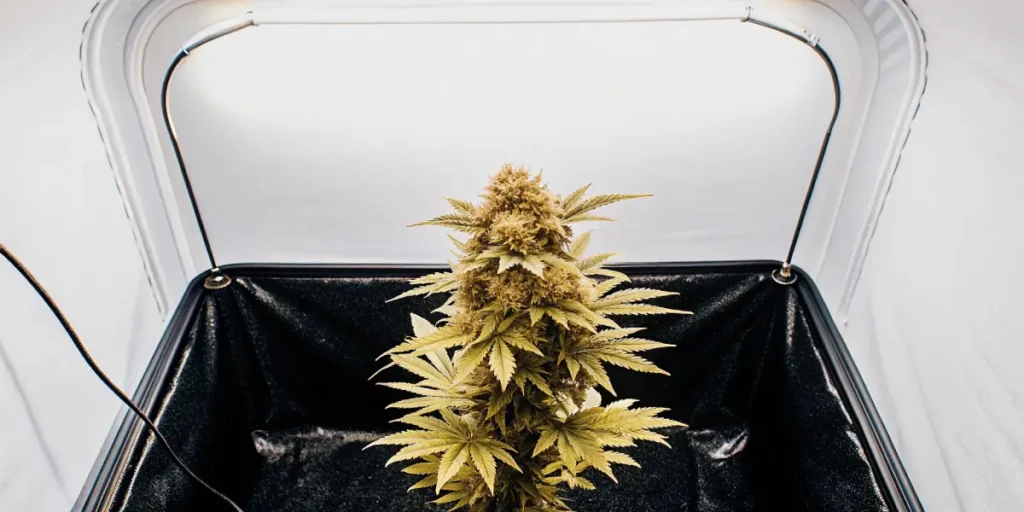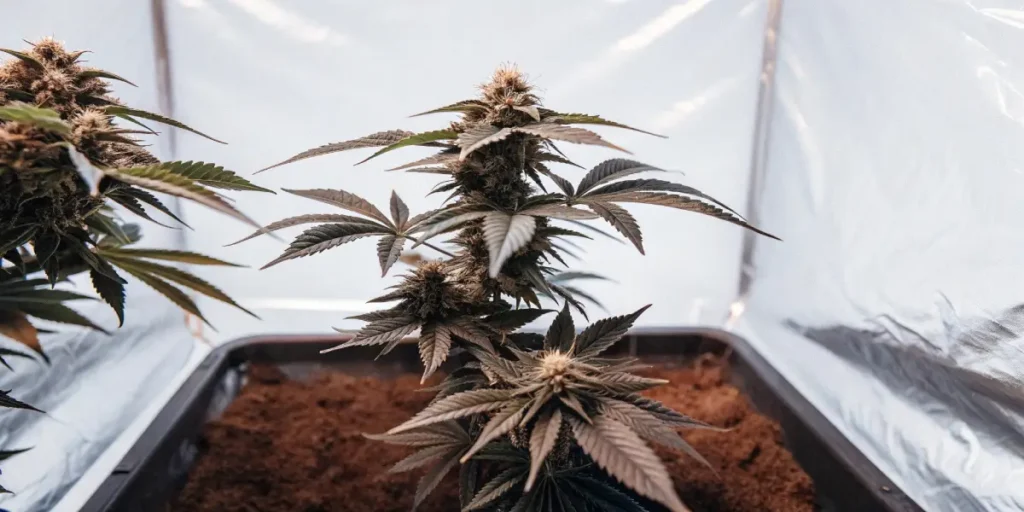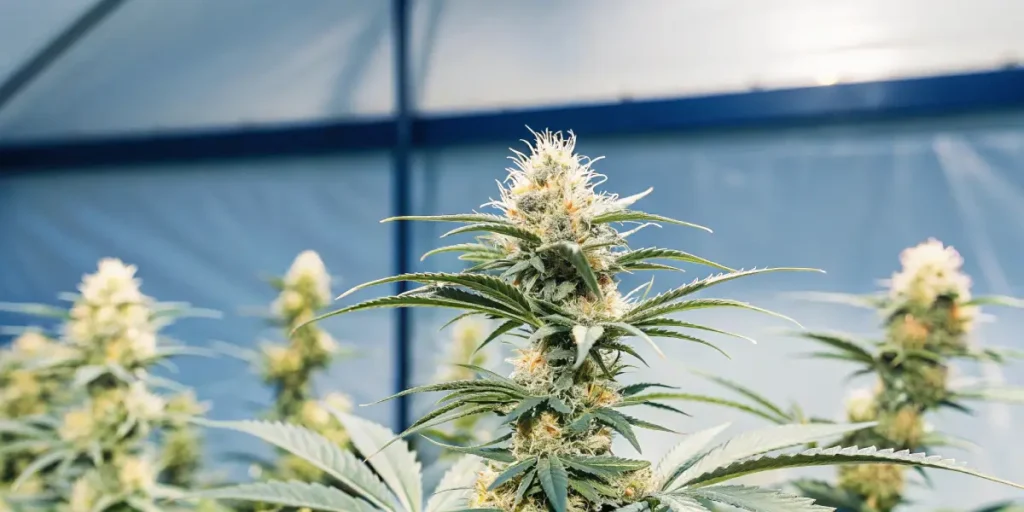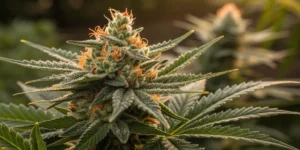Growing Orange Sherbert, a delightful hybrid cannabis strain, can be an exciting and rewarding endeavor for growers. This strain is known for its vibrant orange pistils and sweet citrusy aroma. To start, ensure you have high-quality seeds or clones. Choose a growing medium—soil, coco coir, or hydroponics—based on your preferences and experience. Orange Sherbert thrives in both indoor and outdoor environments but, like all cannabis, it requires specific conditions to flourish.
The next step is to provide the right climate. Orange Sherbert prefers temperatures between 70-85°F (21-29°C) during the day and slightly cooler nights. Maintaining humidity levels around 40-50% during the vegetative stage is crucial, reducing to 30-40% during flowering to prevent mold. This strain adapts well to Sea of Green (SOG) or Screen of Green (ScrOG) techniques, which help maximize yield and manage the plant’s height effectively.
Nutrients play a crucial role in the growth of Orange Sherbert. During the vegetative stage, opt for a nitrogen-rich formula to encourage foliage development. As the plant enters the flowering stage, switch to phosphorus and potassium-rich nutrients to support bud production. Regular feeding schedules, combined with regular pH checks, ensure the plants have the right balance of nutrients, which is essential for vibrant growth and abundant yields.
Lighting is another critical factor, especially for indoor growers. Orange Sherbert requires 18-24 hours of light during its vegetative stage and 12 hours during the flowering stage. Use LED or HPS lights for optimal results. Remember to adjust the height of your lights based on the plant’s growth to avoid light burn. Outdoors, choose a sunny location that gets ample direct sunlight.
Finally, be patient as your Orange Sherbert plants mature. Monitor them for any signs of pests or diseases and take preventative measures. The flowering period typically lasts 8-10 weeks, so watch for the pistils to change color and the trichomes to develop a milky appearance, indicating the perfect time for harvest. With the right care, your Orange Sherbert plants will reward you with bountiful and aromatic buds.
Orange sherbert Strain Overview: Traits, Effects & Genetics
The Orange Sherbert strain is a highly sought-after hybrid known for its exceptional flavor and balanced effects. A product of meticulous breeding, it inherits a rich lineage that combines the best characteristics of its parent strains. The aroma profile is dominated by citrus notes with a sweet undertone, reminiscent of a refreshing sherbet dessert. This strain is also recognized for its vibrant appearance, often showcasing a striking contrast between its bright orange pistils and dense, frosty, trichome-covered buds.
In terms of effects, Orange Sherbert leans towards a balanced high, making it a versatile choice for both recreational and medicinal users. Upon consuming, users typically experience an uplifting cerebral buzz that enhances creativity and social interaction. This is followed by a soothing body relaxation, which helps alleviate stress and tension without inducing lethargy. It’s known for providing a smooth transition between effects, making it suitable for daytime use without fear of becoming overly sedated.
The genetics of Orange Sherbert are a fascinating blend, primarily derived from a mix of potent and flavorful strains. It typically involves an intricate cross between strains like Orange Cream and Purple Urkle, although breeders might use variations to enhance specific traits. These parents contribute to its harmonious mix of indica and sativa properties. The genetic background is tailored to maximize both flavor and therapeutic benefits, with a focus on generating robust plants that yield high-quality buds.
Overall, growers and users alike appreciate Orange Sherbert not just for its palatable flavor and aroma but also for its balanced effects that perfectly cater to a wide range of needs. Its unique genetic profile creates a reliable strain that’s easy to grow, particularly suited for those looking to cultivate a high-yielding plant with robust growth and consistent results. Whether you’re a seasoned cannabis grower or a consumer searching for an exceptional hybrid to enjoy, Orange Sherbert stands out as a prime choice.
Optimal Environment to Grow Orange Sherbert Successfully
Growing Orange Sherbert, a popular cannabis strain known for its vibrant citrus flavors and potent effects, requires a carefully controlled environment. This strain thrives best in well-maintained indoor settings, although it can also flourish outdoors in Mediterranean-like climates with warm temperatures and ample sunlight. The key is to provide a stable environment where temperature, humidity, and light are consistently regulated to cater to the plant’s developmental needs.
Temperature is a crucial factor when cultivating Orange Sherbert. During the vegetative phase, maintain temperatures between 70-85°F (21-29°C). As the plant transitions to the flowering stage, aim to keep the temperature slightly cooler, around 65-80°F (18-27°C), to replicate natural environmental changes and promote healthy bud formation. Sharp fluctuations in temperature can stress the plants, potentially impacting their growth and yield.
Controlling humidity levels is equally important. During the early vegetative stage, Orange Sherbert prefers higher humidity levels of 55-70% to support leaf development. Gradually decrease humidity to 40-50% during the flowering stage to minimize the risk of mold and mildew, which can be detrimental to the plant’s health. Utilizing dehumidifiers or humidifiers can help achieve and maintain these ideal humidity conditions, ensuring optimal growth.
Lighting is another critical component when growing Orange Sherbert. Utilize high-quality LED or HPS grow lights, ensuring that they deliver 18 hours of light during the vegetative stage and 12 hours during the flowering stage. The intensity and spectrum of light should be adjusted to mimic natural sunlight, which will encourage robust growth and resin production.
A well-maintained soil medium enriched with essential nutrients – or a carefully monitored hydroponic setup – will also contribute significantly to the successful cultivation of Orange Sherbert. Ensure the growing medium has excellent drainage to prevent waterlogging, which could harm root development and overall plant vitality. Regular monitoring of pH levels, maintaining a range of 6.0-6.5, will help in optimal nutrient absorption.
Grow Room Setup for Orange Sherbert Plants
Setting up a grow room for Orange Sherbert plants is the first critical step in ensuring a healthy and bountiful harvest. Orange Sherbert, known for its sweet citrus flavor and impressive resin production, thrives best in a well-controlled indoor environment. To begin with, choosing the right location for your grow room is essential. A spare room, large closet, or a purpose-built grow tent can serve as an ideal space. It’s crucial that the location is light-proof to enable precise control over the plant’s photoperiod.
Adequate lighting is a cornerstone of successful Orange Sherbert cultivation. These plants require high-intensity lighting such as LED or High-Intensity Discharge (HID) lamps to mimic the sun’s rays. Aim for a light spectrum that promotes both the vegetative and flowering stages efficiently. Typically, a 600W LED grow light should suffice for a medium-sized grow room. Remember that appropriate distance between the light source and the plant canopy is crucial to avoid light burn while ensuring optimal photosynthetic activity.
Temperature and humidity control are another vital aspect of a successful grow room setup. Orange Sherbert plants prefer temperatures between 68-77°F (20-25°C) during the day and slightly cooler at night. Humidity should be maintained around 60% during the vegetative stage and lowered to 40-50% during flowering to prevent mold and other potential problems. Installing oscillating fans and a reliable exhaust system can help maintain proper airflow and control these environmental factors.
Furthermore, a good growing medium and container are critical for Orange Sherbert plants. Soil-based media with good aeration, or hydroponic systems, are both suitable options. Ensure that the containers offer sufficient drainage to prevent waterlogging. Typically, pots with a capacity of at least five gallons are recommended to allow the roots enough space to expand and support vigorous growth. To empower your plants, applying organic nutrients at each stage of development will boost both flavor and potency.
Finally, monitoring and maintaining a clean grow room is indispensable. Regularly check for signs of pests and diseases, and promptly remove any debris or fallen leaves. Implementing a schedule for feeding, watering, and trimming guarantees healthy Orange Sherbert plants that flourish through their life cycle. With the right setup and attention to detail, cultivating these delightful plants indoors can be both rewarding and fulfilling.
Indoor Growing Tips
Orange Sherbert is a popular hybrid cannabis strain known for its delightful citrus aroma and potent effects. When growing Orange Sherbert indoors, it’s imperative to create an optimal environment to maximize its potential and ensure a healthy yield. Begin by choosing a well-controlled space with the ability to adjust humidity and temperature. This strain thrives in a setting of 21-26°C (70-79°F) with a relative humidity of 40-50% during the vegetative stage. Maintaining these conditions will help prevent mold and pests from affecting your plants.
Lighting is another crucial factor to consider when cultivating Orange Sherbert indoors. Using full-spectrum LED lights will mimic natural sunlight and encourage robust growth. Depending on the developmental stage, adjust the light schedule accordingly. During the vegetative phase, a 18/6 light cycle (18 hours of light, 6 hours of darkness) is essential, promoting vigorous growth and setting the stage for a productive flowering phase, where a 12/12 cycle is recommended. Ensure lights are placed at the appropriate distance from the canopy to prevent light stress or burn.
Orange Sherbert requires a nutrient-rich growing medium to thrive. Opt for high-quality soil or a hydroponic setup, providing essential nutrients like nitrogen, phosphorus, and potassium. Regularly monitor pH levels to ensure they remain between 6.0-7.0 in soil or 5.5-6.5 in hydroponics. Enrich the medium with organic amendments or choose a balanced nutrient solution. Regularly check for signs of nutrient deficiency or toxicity, and adjust feeding schedules accordingly.
Pruning and training are beneficial techniques to optimize space and improve light penetration in an indoor environment. Consider low-stress training (LST) to encourage even canopy growth and maximize bud production. Pay attention to airflow and circulation; install oscillating fans to prevent stagnant air pockets, keeping plants healthy. Regularly inspect plants for any signs of pests or diseases, taking prompt action to maintain overall plant health and ensure a successful harvest.
As your Orange Sherbert plants move toward the flowering stage, monitor environmental conditions more closely. A slight decrease in humidity (30-40%) will help facilitate resin production. Be consistent with your feeding schedule, ensuring adequate nutrient supply without overfeeding. Keep a watchful eye on trichomes to determine the optimal harvest window, capturing the strain’s full terpene and cannabinoid profile. Following these tips will reward growers with dense, aromatic buds and a gratifying indoor growing experience.
Outdoor Growing Tips
Orange Sherbert is a delightful strain known for its vibrant citrus flavor and uplifting effects. When growing this strain outdoors, it is essential to understand its specific needs to achieve a successful yield. The first step is to select a location with ample sunlight, as Orange Sherbert thrives in sun-drenched environments. Aim for a spot that receives at least six to eight hours of sunlight daily to ensure robust growth and high yields.
Next, consider the climate in your region. Orange Sherbert is known to do well in warm, Mediterranean-like climates. The ideal temperature range is between 70°F and 85°F (21°C and 29°C) during the day, with minimal temperature fluctuations at night. Be mindful of humidity levels as well, as excessive moisture can lead to mold and mildew development. Consistently aim for relative humidity levels between 40% and 50% to avoid such issues.
Soil quality is another crucial factor for successful outdoor cultivation of Orange Sherbert. Opt for a rich, well-draining organic soil that is full of nutrients. You may choose to amend the soil with compost or well-rotted manure before planting to enhance fertility. Regularly monitoring soil pH levels is advisable, with the optimal range being 6.0 to 7.0 for Orange Sherbert. This ensures that the plant is able to effectively absorb nutrients from the soil.
Watering practices are equally important for outdoor growers. Orange Sherbert requires consistent watering, but be cautious not to overwater, as this can lead to root rot. It’s best to water deeply and infrequently, allowing the top few inches of soil to dry out between waterings. This encourages deeper root growth and ultimately results in a healthier plant.
Lastly, regularly inspect your plants for signs of pests and diseases. Common outdoor threats include aphids, spider mites, and caterpillars. Utilize organic pest control methods and beneficial insects to maintain a healthy garden. Additionally, prune your Orange Sherbert plants regularly to promote good airflow and discourage mold growth. With these tips in mind, you’re well on your way to cultivating a bountiful and flavorful outdoor crop of Orange Sherbert.

How to Germinate & Propagate Orange Sherbert
Orange Sherbert is a vibrant and flavorful cannabis strain that appeals to both novice and experienced growers. Germinating this strain begins with selecting high-quality seeds, which is crucial for achieving a successful grow. Start by soaking the seeds in warm, distilled water for approximately 12 to 24 hours. This soaking process helps to expedite the germination process by softening the seed shell, allowing the seedling to break through more easily. An alternate method involves placing seeds directly between moist paper towels, ensuring they are kept in a warm, dark place to incubate.
Once the seeds have started to sprout, usually indicated by a small root (or taproot) emerging, carefully move them to a germination medium such as Rockwool cubes, peat pellets, or directly into a light, well-draining soil mix. The chosen medium should maintain adequate moisture without becoming waterlogged. Position the seeds with the taproot pointing downward and cover lightly with medium. Within a few days, the seedlings should break the surface, prompted by warmth, moisture, and perhaps a little encouragement in the form of gentle handling.
Propagation of Orange Sherbert can also be effectively achieved through cuttings, a method known as cloning. Take cuttings from healthy, robust mother plants in the vegetative state to ensure vigorous growth. Each cutting should be about 4 to 6 inches long, with at least two to three leaf nodes. Strip the lower leaves and dip the cut end into a rooting hormone gel or powder. Plant the cutting into a propagation medium, such as perlite or a specialized rooting cube. Maintain humidity levels using a humidity dome or regular misting, combined with consistent light to encourage root development.
Properly caring for nascent Orange Sherbert plants involves monitoring moisture levels, ensuring the cuttings and seedlings receive adequate light without overheating, and maintaining a stable environment. An ideal temperature range is between 70-77°F (21-25°C), paired with a gentle breeze for air circulation to strengthen the young plants. With patience and careful attention to these steps, Orange Sherbert seedlings and cuttings will grow into resilient plants ready for the vegetative stage of their lifecycle.
Vegetative Stage
The vegetative stage is a critical phase for Orange Sherbert cannabis plants, as it’s during this time that the foundation for a healthy, high-yielding plant is established. During the vegetative stage, which typically lasts 3 to 8 weeks depending on growth conditions and desired plant size, the Orange Sherbert plants focus on developing a robust root system and dense foliage. It is essential to prioritize maintaining optimal conditions, such as adequate lighting, consistent temperatures, and proper humidity levels, to promote vigorous growth and prepare your plants for a prolific flowering period.
Lighting is one of the most crucial factors in nurturing Orange Sherbert plants during their vegetative stage. These plants thrive under a light schedule of 18-24 hours of light per day, as this mimics the long days of summer in nature. Utilizing high-quality grow lights, such as LEDs or Metal Halide lamps, will ensure your plants receive the intensity and spectrum required for healthy photosynthesis and growth. Positioning the lights at the correct distance from the plant canopy will prevent light burn while providing adequate coverage for all foliage.
Feeding your Orange Sherbert plants with a balanced nutrient solution is vital during the vegetative stage. These plants require higher nitrogen levels at this time, aiding in leaf and stem development. Utilize a nutrient mix rich in N-P-K proportions suitable for vegetative growth, and regularly monitor pH levels to ensure nutrient uptake is not hindered. Simple practices, like consistent watering schedules and adequate drainage, will also help prevent nutrient lockout and overwatering, helping your plants thrive.
Maintaining an ideal environment is key to the success of your Orange Sherbert plants during their vegetative stage. The optimal temperature range for these plants is between 70-85°F (21-29°C) with humidity levels around 40-70%. Proper air circulation, facilitated by fans or an exhaust system, will aid in strengthening stems, reducing pest risks, and minimizing mold growth. Addressing these environmental factors can significantly impact the overall health and eventual yield of your Orange Sherbert crop.
Training and pruning your Orange Sherbert plants can maximize canopy exposure to light and promote even growth. Techniques such as topping, fimming, or low-stress training can be employed early in the vegetative stage to increase bud sites and potential yields. Regularly inspect your plants for any signs of pests or diseases, addressing issues promptly to ensure uninterrupted growth. By providing attentive care and optimizing conditions during the vegetative stage, you prepare your Orange Sherbert plants for a successful flowering phase and a rewarding harvest.
Flowering: What to Expect
Orange Sherbert is a delightful cannabis strain known for its vibrant aromas and potent effects. As it enters the flowering stage, cultivators can expect a dynamic transformation in their grow rooms. Flowering typically spans 8 to 10 weeks, during which time the plant develops dense, resin-rich buds. One notable characteristic is the strain’s vivid coloration; hues of deep orange and shimmering green become prominent, enhancing visual appeal. During this stage, growers should closely monitor their plants to ensure they receive the optimal conditions for a bountiful harvest.
Expect a significant increase in the plant’s aroma and resin production during the flowering period. Orange Sherbert is renowned for its sweet citrus fragrance, reminiscent of orange and candy. As the buds mature, this intoxicating scent intensifies, captivating growers and signaling that harvest time is approaching. Furthermore, cultivators should be mindful of humidity levels to prevent mold development, which thrives in dense, resin-heavy buds. Adequate ventilation and controlled indoor conditions are essential to maintain the plant’s health in this critical stage.
The flowering stage is also a time for nutrient adjustment. Orange Sherbert plants require a phosphorus-rich diet to support healthy bud development. Implementing a feeding regimen tailored to this strain can significantly enhance the size and potency of the flowers. Growers should consider using bloom-specific nutrients and supplements to provide the plants with the essential elements needed. Monitoring pH levels and ensuring that the nutrient solution is correctly balanced will further optimize the flowering outcome, resulting in a high-quality harvest.
During the flowering phase, light exposure is another vital factor to consider. Orange Sherbert plants generally thrive in a 12/12 light cycle, which simulates the natural conditions that trigger blooming. This period of equal light and darkness encourages robust flower development, bringing out the full potential of the strain. Growers should ensure that the plants are not exposed to light leaks, as this can interrupt the flowering process and lead to underdeveloped buds. By maintaining a consistent light schedule, the quality and yield of the harvest can be significantly enhanced.
Finally, patience and attentiveness are crucial during the flowering stage of Orange Sherbert. Observing the trichomes is a reliable way to determine the optimal harvest time; they transform from clear to milky and eventually, an amber hue, signifying peak potency and flavor. It is important to harvest at the right moment to maximize the plant’s effects and preserve its signature citrus profile. With careful attention to environmental conditions, nutrient needs, and harvest timing, growers can expect a successful flowering phase that delivers a rewarding bounty of exquisite Orange Sherbert cannabis.
Fertilizers & Nutrient Schedule
Orange Sherbert is a notably resilient cannabis strain, famed for its delightful citrus aroma and high-yield potential. For cultivators intending to maximize both the yield and potency of this delightful strain, understanding and implementing an appropriate fertilization and nutrient schedule is paramount. Proper feeding ensures that the plants have access to all the essential nutrients they need during the different stages of their growth cycle, ultimately leading to a bountiful and potent harvest.
During the seedling and vegetative stages, ensuring that Orange Sherbert receives a steady supply of nitrogen will be crucial. Nitrogen promotes vigorous growth and the development of lush, green foliage. A balanced nutrient mix with a higher ratio of nitrogen should be used during these stages. A typical schedule might involve feeding a water-soluble fertilizer every one to two weeks, making adjustments based on the plants’ appearance and growth rate. It’s essential to monitor the pH levels of the growing medium, keeping it in the ideal range of 6.0 to 7.0 for soil grows, to ensure proper nutrient uptake.
As the plant transitions into the flowering stage, the nutrient needs of Orange Sherbert will shift significantly. The focus should turn toward phosphorus and potassium, which support bud development and enhance the plant’s overall resilience. Feeding should be adjusted to include fertilizers with a higher phosphorus-to-potassium ratio, such as a 10-30-20 blend, to encourage abundant and robust blooms. At this stage, reducing nitrogen levels is advisable to prevent excess foliage growth, redirecting the plant’s energy toward flower production.
Throughout the entire growth cycle, cultivators should be vigilant for signs of nutrient deficiencies or excesses, adjusting the feed schedule accordingly. Leaf discoloration, browning tips, or stunted growth can indicate potential nutritional issues. A proactive approach involves flushing the growing medium periodically to prevent nutrient buildup, ensuring healthy and vibrant Orange Sherbert plants. By adhering to a structured but flexible feeding schedule that responds to the plants’ needs, growers can optimize both the quality and quantity of their harvest.
Pest and Disease Prevention for Healthy Cannabis Plants
When cultivating Orange Sherbert, a popular cannabis strain known for its vibrant colors and citrusy aroma, ensuring your plants remain healthy and productive is paramount. Effective pest and disease prevention is crucial for maintaining the quality and yield of your crop. One essential practice is maintaining a clean growing environment. Start by using sterilized tools and containers to prevent the introduction of pathogens. Regularly clean your growing area and remove dead leaves or plant material, which can harbor pests and diseases.
Implementing integrated pest management (IPM) is highly recommended for Orange Sherbert cultivation. IPM involves using a combination of biological controls, such as beneficial insects, and cultural practices to manage pest populations. For instance, introducing ladybugs or predatory mites can help keep aphid and spider mite populations in check. Additionally, rotating your crops and altering the growing environment, such as adjusting humidity and temperature levels, can deter the proliferation of pest and disease issues.
Routine monitoring of your Orange Sherbert plants is critical for early detection and prevention of pest or disease outbreaks. Regularly inspect the leaves, stems, and soil for signs of pests like aphids, spider mites, and whiteflies. Look for discoloration, wilting, or unusual spotting, which could indicate the presence of disease. If you identify a problem, act swiftly to address it by removing affected plant parts and employing organic or chemical treatments as appropriate, depending on the severity of the infestation.
Furthermore, employing preventive measures such as the use of neem oil, horticultural soap, or diatomaceous earth can also aid in creating a protective barrier against potential threats. These products are generally safe for use on cannabis plants and can help keep common pests at bay without affecting the plant’s health or the quality of the buds. In summary, by diligently employing these strategies, you can ensure that your Orange Sherbert plants remain healthy and flourishing, resulting in a successful and bountiful harvest.
Harvesting & Drying Orange Sherbert the Right Way
Harvesting your Orange Sherbert plants at the optimal time is crucial for ensuring the best flavor and potency of your buds. Typically, Orange Sherbert, like many cannabis strains, is ready to harvest approximately 8 to 9 weeks after flowering begins. The key signs to look for include the trichomes turning from clear to a milky white, sometimes showing an amber hue, and the pistils darkening and curling in. Observing these changes will help you decide the perfect time to harvest, preserving the distinctive sweet citrus notes and potent effects that Orange Sherbert is known for.
When it comes to harvesting Orange Sherbert, it’s important to prepare your tools and environment beforehand. Use clean, sharp scissors or pruning shears to cut the branches at their base, and handle the buds delicately to avoid damaging the trichomes. It’s advisable to carry out the harvesting process in a cool, dark, and clean environment to prevent any premature exposure to light and heat, which could degrade the cannabinoids and terpenes, ultimately affecting the quality of your harvest.
Drying is a crucial post-harvest step that must be done meticulously to ensure the preservation of Orange Sherbert’s unique flavor and aroma profile. Hang the freshly cut branches upside-down in a dark room with a relative humidity level of 45% to 55% and a temperature between 60-70°F (15-21°C). Adequate airflow is essential; therefore, using fans to circulate air but not directly at the plants can aid in an even drying process. Typically, Orange Sherbert flowers take about 7 to 10 days to dry properly before proceeding to the curing step.
Checking the buds regularly during drying is important as it helps prevent mold growth and ensures a balanced moisture content. A sign that drying is complete is when the smaller stems snap instead of bending between your fingers. After drying, curing your Orange Sherbert buds in airtight glass jars for a minimum of two weeks will enhance their flavor and aroma, improving the overall smoking experience. Store the jars in a dark, cool place, opening them occasionally during the first few days to allow moisture to escape and achieve the desired quality.
Orange sherbert Strain Type: Indica, Sativa or Hybrid?
Orange Sherbert is a captivating cannabis strain celebrated for its balanced blend, making it a compelling choice for a wide demographic of cannabis enthusiasts. This strain is classified as a hybrid, skillfully crafted to provide users with the best of both Indica and Sativa worlds. It is known for its enhanced effects that combine a cerebral high from its Sativa lineage and a soothing, body-focused experience characteristic of Indica strains. This potent hybrid strikes a delightful balance, delivering a versatile experience that appeals to both recreational and medicinal users.
The genetic background of Orange Sherbert is a fascinating amalgamation of well-known strains. It hails predominantly from Orange Cream, Cherry Pie, and Lemon Sherbert, combining specific traits from each to create something uniquely its own. The Sativa influence, primarily from Orange Cream, contributes to the uplifting and creative head high aspects for which Orange Sherbert is renowned. Users often report feelings of euphoria and increased sociability after consumption, making this strain a perfect accompaniment for daytime activities or social gatherings.
On the other end of the spectrum, Orange Sherbert’s Indica properties provide notable relaxation effects. Cherry Pie and Lemon Sherbert lean into the Indica profile, offering relaxation, muscle relief, and a sense of calm that can help in managing stress and anxiety. The calming effect transitions smoothly from the initial mental stimulation, making Orange Sherbert an ideal strain for users seeking to unwind after a busy day. In essence, the hybrid nature of Orange Sherbert ensures that consumers can enjoy a harmonious blend of invigorating and relaxing effects.
In the growing community, Orange Sherbert is praised for its balanced structure, which mirrors its balanced effects. The plant itself typically grows to a moderate height and showcases a sturdy structure, supporting its prolific yield of dense, resin-coated buds. Being a hybrid, it naturally adjusts to various growing conditions and can be cultivated successfully both indoors and outdoors. Its dynamic genetic makeup enables it to evolve through different climates with relative ease, making it an attractive option for both novice and experienced growers.
Why Grow Orange Sherbert? Key Benefits for Cultivators
Orange Sherbert is an irresistible choice for cultivators, offering a multitude of benefits that make it a prime candidate for any growing operation. This strain stands out due to its exceptionally balanced genetics, derived from a mix of Orange Cream, Purple Urkle, and Cherry Pie. The result is a well-rounded plant that combines the best traits of each parent strain, assuring a robust growth cycle and a diverse range of effects for users. This balance makes it appealing to both medicinal and recreational users, increasing market potential for growers.
One of the key reasons to grow Orange Sherbert is its enticing flavor profile. Cultivators are drawn to its citrusy aroma mixed with subtle earthy undertones, which not only satisfies the palate but also appeals to a broad audience of cannabis consumers. The strong and pleasant terpene profile of Orange Sherbert enhances its commercial attractiveness, helping the final product stand out in a crowded market. Additionally, a unique selling point such as this can be especially beneficial for growers looking to carve out a niche in competitive cannabis markets.
Moreover, Orange Sherbert is recognized for its vigorous growth and generous yield potential. It is a relatively easy strain to cultivate, adapting well to both indoor and outdoor environments. This adaptability means that novices and experienced growers alike can successfully cultivate Orange Sherbert without the need for overly complex techniques. Furthermore, its resilience to common pests and diseases allows for a more straightforward growing process, reducing the need for extensive plant protection measures and ensuring a cost-effective production cycle.
Additionally, Orange Sherbert’s effects are profoundly calming and uplifting, making it a sought-after choice for those dealing with stress or anxiety. For cultivators, this translates to a product that meets the rising consumer demand for strains with therapeutic benefits, thus broadening the client base. By emphasizing the strain’s health benefits, growers can capitalize on the growing market trend towards wellness and holistic health.
Potential Challenges When Growing Orange Sherbert
Growing Orange Sherbert, like any cannabis strain, presents its own set of challenges that cultivators need to address for a successful harvest. One of the primary challenges is managing environmental conditions, as this strain thrives in a stable climate. Orange Sherbert prefers temperatures between 20-26°C (68-78°F) with humidity levels around 40-50% during the flowering stage. Any significant fluctuations can lead to growth issues or impact bud quality.
Another challenge growers face is ensuring adequate nutrient management. Orange Sherbert is known for its vibrant orange hairs and pungent aroma, which require balanced nutrition. Overfeeding or underfeeding can cause nutrient lockout or deficiencies, leading to stunted growth or discolored leaves. Regular monitoring and adjusting the nutrient regimen based on the plant’s needs can help in overcoming these issues.
Pest control is also a crucial factor when cultivating Orange Sherbert. This strain is susceptible to common pests like spider mites, aphids, and whiteflies, which can damage the plants and reduce yield. Implementing integrated pest management practices, such as introducing beneficial insects and maintaining cleanliness in the growing area, can mitigate these problems and keep the plants healthy.
Additionally, Orange Sherbert has a relatively long flowering period of around 8-10 weeks, which requires patience and careful observation. During this phase, it’s essential to support the plant’s structure, as the dense buds can become heavy and prone to snapping. Providing stakes or screens can help maintain their integrity and optimize light exposure for better yields.
Finally, managing space effectively is vital, as Orange Sherbert can become quite bushy. Pruning and training techniques like topping or low-stress training (LST) can improve airflow and light penetration, reducing the risk of mold and mildew, particularly in humid environments. With attention to these challenges, cultivators can enjoy a rewarding experience growing Orange Sherbert.

Is Orange Sherbert Worth Buying? Here’s What You Need to Know
Orange Sherbert is a unique and flavorful cannabis strain that has been gaining significant attention from growers and consumers alike. Its genetic lineage includes a cross between Orange Cream, Purple Urkel, and Cherry Pie, resulting in a tantalizing mix of fruity and citrus flavors. The strain stands out with its vibrant orange pistils and frosty trichomes, adding to its visual and aromatic appeal. For those seeking a well-rounded experience, Orange Sherbert offers a balanced hybrid effect that combines the uplifting qualities of a Sativa with the relaxing properties of an Indica.
Before purchasing Orange Sherbert seeds, it is crucial to consider what you are looking for in a cannabis strain. This strain is particularly notable for its strong terpene profile, highlighted by dominant notes of limonene, myrcene, and caryophyllene. These compounds not only contribute to its invigorating aroma but also enhance the strain’s potential therapeutic benefits, such as stress relief and mood enhancement. However, due to its potency, it may not be the best choice for novice users or those with a low tolerance to THC.
In terms of cultivation, Orange Sherbert can be a rewarding strain for both novice and experienced growers. It is known for its robust nature, making it relatively easy to cultivate, whether indoors or outdoors. The plant typically flowers within 8 to 9 weeks and can produce a generous yield under optimal conditions. Growers will appreciate the strain’s resistance to pests and molds, as well as its adaptability to various growing environments, which makes it a versatile addition to any garden.
For consumers, the cost-benefit analysis of purchasing Orange Sherbert largely depends on personal preferences and intended use. Its unique flavor profile and balanced effects make it worth the investment for those who prioritize taste and versatility. On the other hand, if you are primarily seeking a heavy-hitting sedative strain or one that delivers a pure cerebral high, you might want to explore other options. Nevertheless, for those who appreciate a multi-dimensional experience, Orange Sherbert is certainly a worthy contender.
To summarize, Orange Sherbert proves to be a worthwhile choice for growers and consumers focused on a unique sensory experience coupled with a balanced effect. Whether you’re growing for personal use or production, this strain’s distinctive flavor, ease of cultivation, and substantial yield present compelling reasons for giving it a try. Ultimately, it offers a rare blend of qualities that cater to enthusiasts seeking a flavorful journey and a relaxing escape.
FAQs about Orange Sherbet
What makes Orange Sherbert different from other cannabis strains?
Orange Sherbert stands out for its vibrant orange pistils, sweet citrus aroma, and balanced hybrid effects. Unlike many strains that lean heavily toward Indica or Sativa, Orange Sherbert delivers a smooth blend of uplifting mental clarity and relaxing body effects — making it ideal for both day and evening use.
How long does it take to grow Orange Sherbert from seed to harvest?
The complete growth cycle of Orange Sherbert typically lasts around 16 to 20 weeks. The flowering phase alone takes 8–10 weeks, depending on environmental conditions, nutrient balance, and whether it’s grown indoors or outdoors.
What’s the best environment to grow Orange Sherbert successfully?
Orange Sherbert thrives in warm, Mediterranean-like conditions with temperatures between 70–85°F (21–29°C) during the day. Indoors, maintaining humidity levels around 40–50% and providing consistent airflow helps prevent mold and maximize yield.
What nutrients does Orange Sherbert need for optimal growth?
During the vegetative stage, Orange Sherbert benefits from nitrogen-rich nutrients to promote strong leaf growth. Once flowering begins, switch to phosphorus and potassium-based fertilizers to enhance bud development and resin production.
Can beginners grow Orange Sherbert successfully?
Yes, Orange Sherbert is considered beginner-friendly due to its resilience and adaptability. It performs well in both soil and hydroponic systems and is naturally resistant to common pests and diseases — making it a solid choice for first-time growers.





